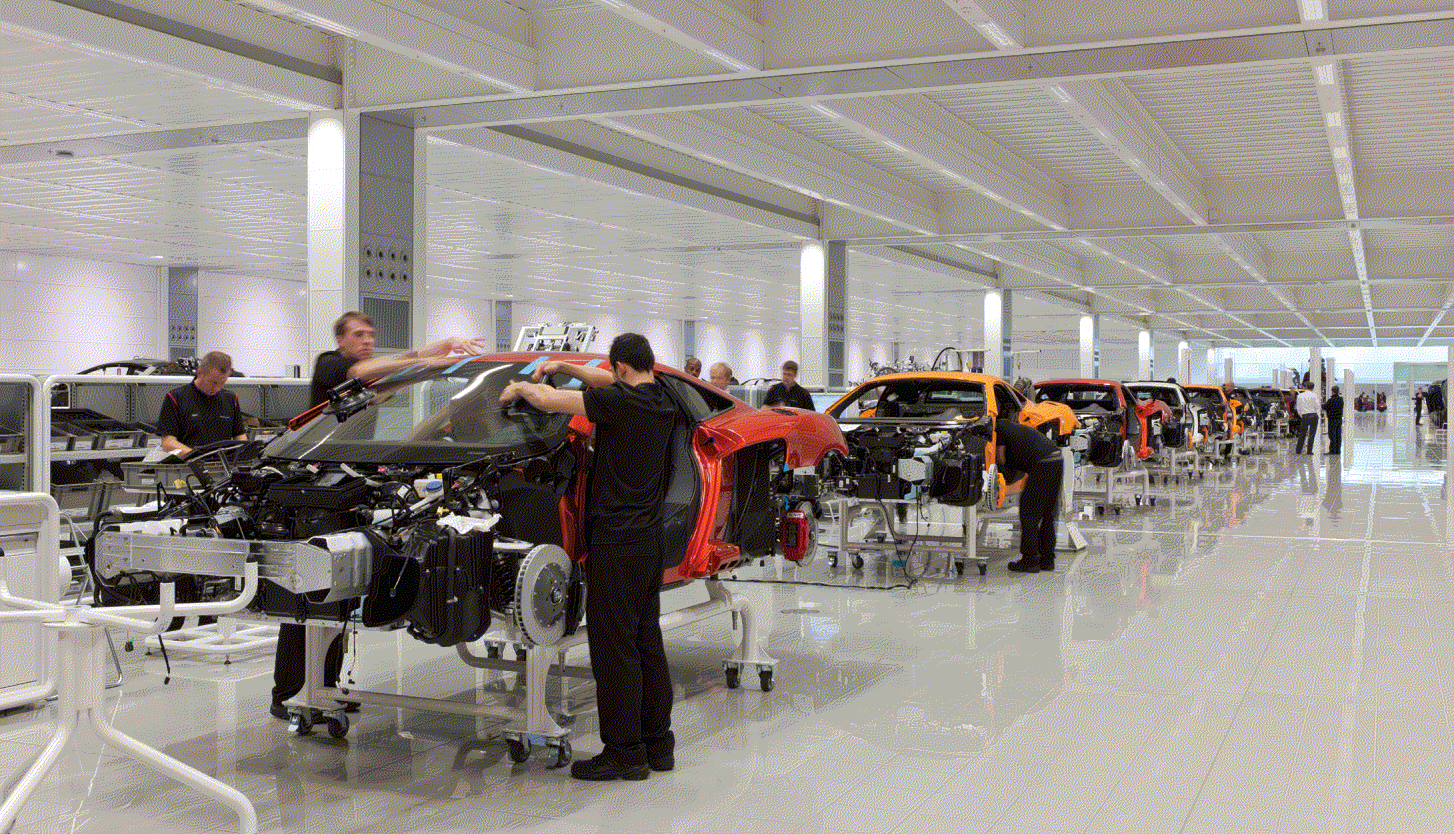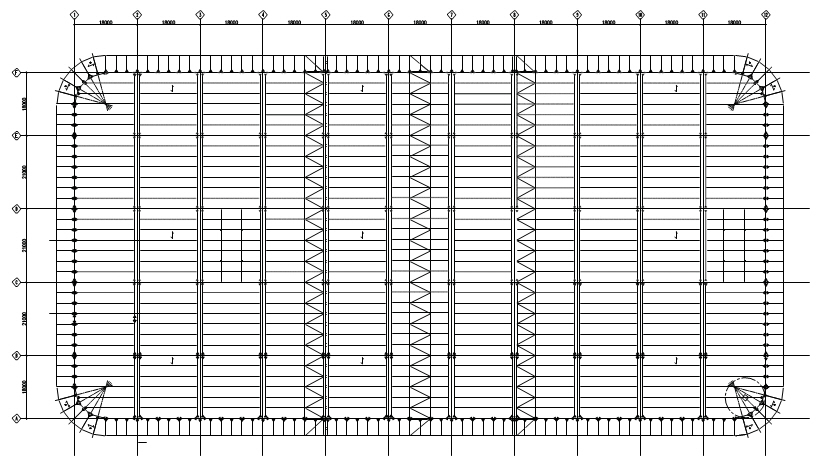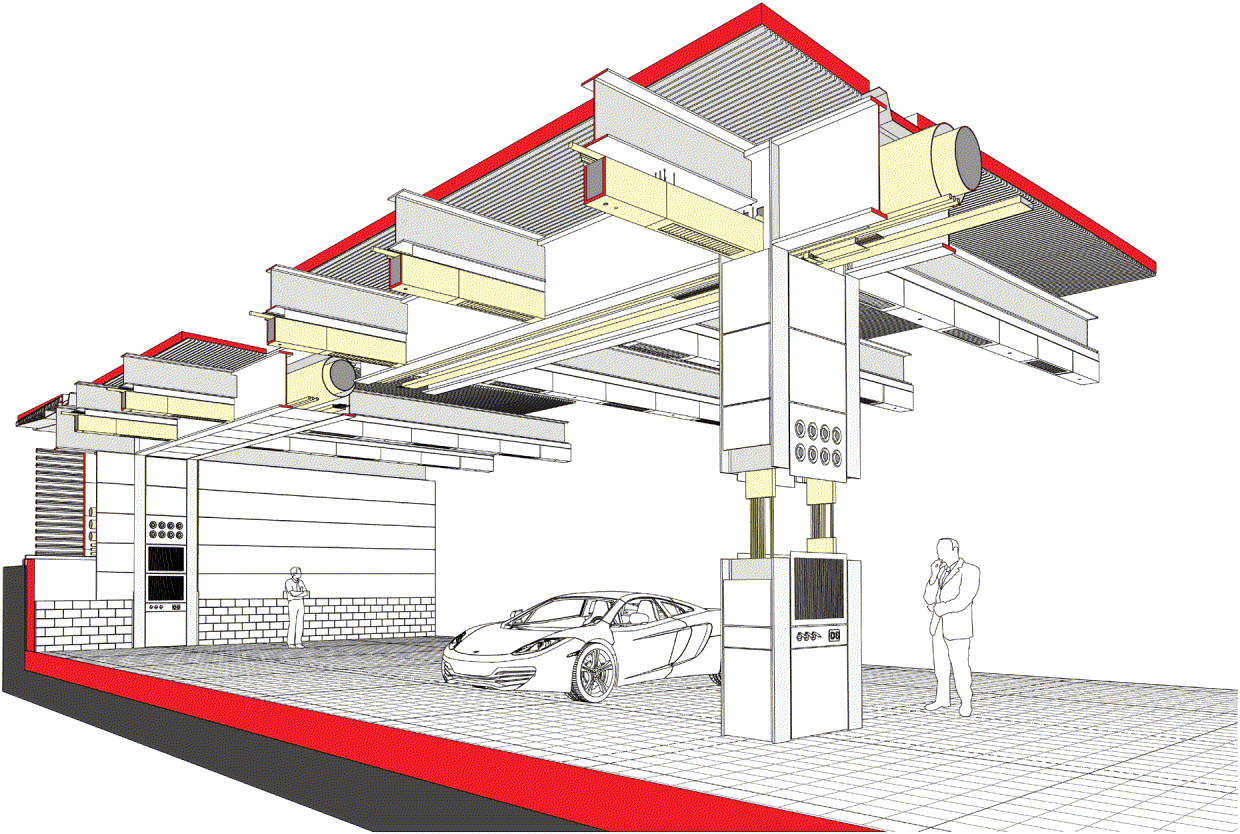McLaren Production Centre
Contents |
[edit] Introduction
Opened by the Prime Minister on 17th November 2011, McLaren’s new Production Centre in Woking is the manufacturing facility for the McLaren MP4-12C super sports car. The design was developed to provide 34,500m2 internal area to meet the ethos set by Ron Dennis, Executive Chairman of McLaren Group and McLaren Automotive: “Our buildings make a powerful statement about what the McLaren Group stands for: performance, technology, inspired design, innovation and meticulous attention to detail, all while operating in sympathy with the environment.”
The project was managed and administered by McLaren. The architects were Foster + Partners, who also designed the neighbouring McLaren Technology Centre. Buro Happold were appointed as structural engineers and were responsible for producing the structural Employers Requirements for the new project. The detailed design was developed through to construction information by Sir Robert McAlpine under a design and build contract to meet the demanding 54 week construction programme. Foster + Partners and Buro Happold then assisted McLaren during the fit-out when £15m of production equipment, including the paint shop, were installed and commissioned.
The building designers (architect, structural and building services engineers) worked in collaboration with McLaren and the automotive designers to achieve a fully integrated building that works with the production flow developed for the cars. This ensures that no compromises are made to the assembly process, and that the finish quality of the building complements the high level of design of the cars.
[edit] Design Concepts
As the site was located in the greenbelt, the design had to comply with very tight planning restrictions on building height set in relation to the small grassy knoll located in the centre of the site. This necessitated sinking the building within the landscape, requiring the excavation of 180,000m3 of soil (equivalent to nearly 70 Olympic sized pools). The excavated material was retained and used to re-landscape the rest of the site. Given the high water table, presence of contamination from an old landfill site and the need for a class 4 dry basement environment, this was not without its challenges.
The resulting building is two story, with the buried portion being concrete, and the above ground elements being steel. The building was sensitively designed to integrate into the landscape to minimise its visual impact.
The super-structure is designed using double primary beams and columns so that all the services, including air supply, power, data, lighting and sprinklers, are concealed within the structural steel frame. The air is supplied at low level within the double columns to provide ventilation via displacement, giving improved environmental conditions for less energy. Beneath the air supply is a slot for panels installed during the fit-out to provide data, single and three phase power and compressed air required for the assembly process.
Key aspects to the design are its simplicity and the high level of repetition. A cross grid 18m, 21m, 21m, 21m and 18m was selected to optimise the working aisle widths beneath. These are then repeated on an 18m grid for 12 bays along the length of the building. Primary, secondary and tertiary beams were then optimised for these spans and repeated throughout the building.
[edit] Design Details
[edit] Sub-structure
Given the generous site dimensions, the construction of the 180 x 70m basement that extended under about 3/4 of the building footprint was done as an open excavation. However, before any construction could begin, the water table had to be lowered that required a network of boreholes to be installed around the perimeter of the site. After extensive negotiations with the local water authorities and planners consent was given to discharge into the adjacent watercourse, and construction could begin.
With the basement being some 4-6m below ground level, and the watertable being at almost ground level, the natural buoyancy of the basement exceeded the weight of the building. This enabled the foundations to comprise solely of 1,300 tension piles that were installed on a 3.3m grid, with each pile being designed for a 500kN uplift load. The 600mm thick basement slab was then designed to resist these uplift pressures and transfer the columns loads in both their temporary (de-watered) and final (buoyant) states.
Waterproofing was done using traditional tanking with a further level of protection being provided using a “delta membrane” beneath the final screed floor. Any water ingress was then discharged into gulleys formed in the slab that drained to sumps at each end of the building. All other drainage was located in trenches formed in the basement slab to prevent any penetrations through the waterproofing layers.
On completion of the main basement, a cut and cover tunnel was constructed to link the Production Centre with the Technology Centre. Where this penetrated the original diaphragm wall of the MTC a complex sequence of works was used to maintain the water integrity of the MTC.
Once the basements were fully watertight, the pumping was gradually turned off and monitoring was carried as the watertable rose. The basement remained dry.
[edit] Super-structure
The detailing of the key interfaces was carefully considered to meet the architectural, structural and building services aspiration and a prototype of a typical bay was fabricated and installed. On approval of the prototype was received, fabrication could commence and the steel was erected on site as the concrete box progressed.
Although the bulk of the internal steel elements are standardised, the perimeter of the building and the entrance drums are expressed to match the visual appearance of the Technology Centre. Elegantly detailed spiral stairs and viewing galleries were also added to enhance the visitors experience when entering from the Technology Centre.
In the majority of locations the steelwork is left exposed. These areas received a high quality painted finish that matched the paint quality of any architectural finishes to give a very clean and consistent aesthetic to the space. Ceilings are used to conceal the services along the main distribution spines that run the length of the building that incorporate acoustic absorbency to control the reverberation of the space. Detailing avoids ledges and recesses to help maintain a pristine environment in keeping with the cars and ethos of the company.
The building was designed in parallel with the development of the process equipment, and recesses and voids were left for these items that included double height paint booths, testing and washing booths. The inherent flexibility of steel allowed for minor modifications to be made on site to account for the final detailed interface that gave the team the confidence to proceed with the production of the steel frame before the detailed fit-out requirements were known.
This article was created by --Buro Happold.
Featured articles and news
Key points for construction at a glance with industry reactions.
Functionality, visibility and sustainability
The simpler approach to specification.
Architects, architecture, buildings, and inspiration in film
The close ties between makers and the movies, with our long list of suggested viewing.
SELECT three-point plan for action issued to MSPs
Call for Scottish regulation, green skills and recognition of electrotechnical industry as part of a manifesto for Scottish Parliamentary elections.
UCEM becomes the University of the Built Environment
Major milestone in its 106-year history, follows recent merger with London School of Architecture (LSE).
Professional practical experience for Architects in training
The long process to transform the nature of education and professional practical experience in the Architecture profession following recent reports.
A people-first approach to retrofit
Moving away from the destructive paradigm of fabric-first.
International Electrician Day, 10 June 2025
Celebrating the role of electrical engineers from André-Marie Amperè, today and for the future.
New guide for clients launched at Houses of Parliament
'There has never been a more important time for clients to step up and ...ask the right questions'
The impact of recycled slate tiles
Innovation across the decades.
EPC changes for existing buildings
Changes and their context as the new RdSAP methodology comes into use from 15 June.
Skills England publishes Sector skills needs assessments
Priority areas relating to the built environment highlighted and described in brief.
BSRIA HVAC Market Watch - May 2025 Edition
Heat Pump Market Outlook: Policy, Performance & Refrigerant Trends for 2025–2028.
Committing to EDI in construction with CIOB
Built Environment professional bodies deepen commitment to EDI with two new signatories: CIAT and CICES.
Government Grenfell progress report at a glance
Line by line recomendation overview, with links to more details.
An engaging and lively review of his professional life.
Sustainable heating for listed buildings
A problem that needs to be approached intelligently.
50th Golden anniversary ECA Edmundson apprentice award
Deadline for entries has been extended to Friday 27 June, so don't miss out!
CIAT at the London Festival of Architecture
Designing for Everyone: Breaking Barriers in Inclusive Architecture.
Mixed reactions to apprenticeship and skills reform 2025
A 'welcome shift' for some and a 'backwards step' for others.






























